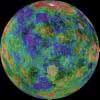
 |
ephemeris.com |
| NASA/JPL |
| Home | Ephemeris | Solar System | History | Space & Time | Software | Books | Links | Feedback |
| ephemeris - Latin, originally from the Greek "ephémeros, -on," daily. An almanac of the daily motions of the planets and stars. |
| ephemeris.com - A website devoted to information about time and motion in the universe. |
The Solar System is the "system" of planets, asteroids, and comets that orbit around our Sun. Our Solar System is in the Milky Way galaxy — that bright band of stars you can see going across the sky at night. There are about 200,000,000,000 (200 American billion) stars in the Milky Way galaxy. Our Sun is just one. The Milky Way is a spiral galaxy. Newer suns (such as our Sun) are in the spiral arms. Older suns are in the center of the galaxy. Our Solar System is in the Orion Arm of the Milky Way.
The planetary symbols of our solar system appear on the pillar below at the entrance of the Lowell Observatory in Flagstaff, Arizona, in the United States. Incidentally, this is the observatory where Pluto was discovered and so had the honor of choosing its name. The symbols, in order, are:

Photo: ©2019 Paul Hardy |
|
The Solar System planet order is easy to remember with this classic phrase: "My Very Educated Mother Just Sent Us Nine Pickles" — My (Mercury), Very (Venus), Educated (Earth), Mother (Mars), Just (Jupiter), Sent (Saturn), Us (Uranus), Nine (Neptune), Pickles (Pluto)!
Jump to a section on this page: Sagittarius A-Star, Sun, Mercury, Venus, Earth, Moon, Mars, Jupiter, Saturn, Uranus, Neptune, Pluto, Eris, Quaoar, Asteroids, Comets, Sedna
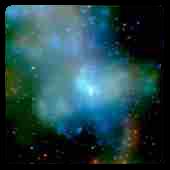 (Image NASA et al.) Our Solar System revolves around the center of the Milky Way Galaxy
(the Galactic Center). A large Black Hole lies at this center. An unusual
concentration of stellar matter surrounds this Black Hole. This was
discovered in February 1974 by Bruce Balick and
Robert Brown, and named Sagittarius A* (pronounced "Sagittarius A star").
(Image NASA et al.) Our Solar System revolves around the center of the Milky Way Galaxy
(the Galactic Center). A large Black Hole lies at this center. An unusual
concentration of stellar matter surrounds this Black Hole. This was
discovered in February 1974 by Bruce Balick and
Robert Brown, and named Sagittarius A* (pronounced "Sagittarius A star").
Sagittarius A* was determined to be the center of the Milky Way, about 26,000 light years from our Solar System. We know the center is a Black Hole from observations of nearby suns in very fast orbits around it, showing high gravitational attraction. In 1999, knowing that Sagittarius A* was the center of the Milky Way Galaxy allowed astronomer Mark Reid and associates at the Harvard-Smithsonian Center for Astrophysics to calculate that our Solar System takes approximately 226 million years to revolve around the Galactic Center.
On 1 April 2004, astronomers announced they had accurately measured the size of Sagittarius A* with the Very Long Baseline Array (VLBA) radiotelescope, with stations spread across the Earth. Sagittarius A* appears to be the diameter of the Earth's orbit around the Sun (93 million miles). The central Black Hole is about 14 million miles in diameter, but astronomers have not yet been able to measure it accurately. They expect to find its size by monitoring shorter and shorter radio wavelengths, until they see light from Sagittarius A* fall off at a wavelength that corresponsds to the size of the Black Hole at its center. For more on the Galactic Center, see Galactic Center Research at the Max-Planck Institute.
 Our Sun contains mostly hydrogen and helium atoms.
Gravity holds these atoms together. Hydrogen atoms (with one proton in their
nucleus) are converted into helium atoms (with two protons in their nucleus).
The reaction that produces this fusing of atoms is called
"nuclear fusion." Protons from hydrogen atoms are so close in the Sun that
they "fuse" together. The tremendous energy that nuclear fusion in the Sun
creates produces the Sun's light and heat.
Our Sun contains mostly hydrogen and helium atoms.
Gravity holds these atoms together. Hydrogen atoms (with one proton in their
nucleus) are converted into helium atoms (with two protons in their nucleus).
The reaction that produces this fusing of atoms is called
"nuclear fusion." Protons from hydrogen atoms are so close in the Sun that
they "fuse" together. The tremendous energy that nuclear fusion in the Sun
creates produces the Sun's light and heat.
The temperature in the Sun's center (the core) is about 27,000,000 (27 million) degrees Farenheit (about 15 million degrees Centigrade). The surface temperature is about 6,100 degrees Centigrade. The surface temperature of our Sun and other stars determine the type of visible light they produce. This is known as the "color temperature." As a perfect black body (known as a Planck Black Body) heats, it becomes infrared, then visible red. As it heats more, it turns orange, then yellow. As it heats still more, it generates more blue light than red or green. Finally, it shifts towards ultraviolet light.
The ratio of blue to green to red light indicates an object's "color temperature." A 100-Watt tungsten bulb has a color temperature of about 2900 degrees (much cooler than the Sun's color temperature of 6100 degrees). If you take a picture indoors at night using tungsten bulbs with daylight film, it appears yellow. The color temperature is why. Tungsten bulbs don't have as much blue light as sunlight. Electronic flashes have more blue light than tungsten bulbs, so their light looks natural on daylight film. Ordinary daylight film is usually balanced for a color temperature of 5500 degrees. Electronic flash equipment typically looks like it has a color temperature of 5000-6000 degrees Centigrade.
Different stars have different color temperatures. If you photograph stars with daylight film (using a long enough exposure), you'll see that some stars appear reddish and orange. Those stars are cooler than our Sun. Others appear bluish. Those stars are hotter than our Sun. Stars that appear white on daylight film have a color temperature of about 5500 degrees, and so are about the same surface temperature as our Sun. One interesting constellation to photograph to see different star colors is Orion. See the "Comets" section below and look at the different colors of the stars in the picture. The blue ones are hotter than the orange ones.
Our Sun is about 4,600,000,000 (4.6 American billion) years old. Slowly over these billions of years, the Sun's hydrogen is converted into helium. Hydrogen atoms have one proton in their nucleus. Helium atoms have two protons. As more of the hydrogen converts into helium, the Sun expands. Our Sun will expand to become a "red giant" in about 5,000,000,000 (five American billion) years.
The Sun has two unusual features because it is a fluid body. It rotates faster at its equator (about 25 days) than at its poles (about 33 days). We know this by observing another unusual feature of the Sun, its sunspots. Sunspots are dark areas on the Sun's surface. They are believed to be storms with magnetic activity. They increase and decrease over time, following the 11-year Sunspot Cycle. Sunspot activity on the Sun charges up our Earth's Ionosphere. The charged Ionosphere lets radio waves bounce more effectively back to Earth, and improves long distance radio coverage (especially in the shortwave radio bands). The Sunspot Cycle was at a maximum in 2001, and now is decreasing in its 11-year cycle.You can see what the Sun looks like now and the location of current sunspots at The ESA/NASA SOHO Website. Warning: do not look directly at the Sun. Looking at the Sun can quickly cause permanent eye damage.
 Mercury is the closest planet to the Sun, so the Sun's gravity attracts it the
most. As a result, Mercury orbits around the Sun faster than any other planet.
Mercury orbits the Sun in about 88 days.
Mercury is the closest planet to the Sun, so the Sun's gravity attracts it the
most. As a result, Mercury orbits around the Sun faster than any other planet.
Mercury orbits the Sun in about 88 days.
Mercury is so close to the Sun, and the Sun is so bright, that we can only see Mercury just before sunrise or just after sunset. When it is visible, Mercury always appears just above the horizon.
Because Mercury travels so fast across the sky, the ancient Greeks and Romans
named it after their mythological Messenger god.
Venus
 Venus is the second closest planet to the Sun. That, and its permanent cloud
cover that reflects sunlight, makes Venus the brightest planet seen from the Earth.
The atmosphere of Venus is poisonous carbon dioxide with sulfuric acid clouds.
Venus orbits the Sun in about 245 days. Its day (243 Earth days) is almost as
long as its year, and it spins on its axis in the reverse direction that the
Earth spins.
The photo on the left shows an ultraviolet image of Venus from the Hubble Space
Telescope. Ultraviolet and infrared imaging are more difficult on Earth because
the atmosphere absorbs much ultraviolet light, and because the Earth itself has
infrared heat.
Venus is the second closest planet to the Sun. That, and its permanent cloud
cover that reflects sunlight, makes Venus the brightest planet seen from the Earth.
The atmosphere of Venus is poisonous carbon dioxide with sulfuric acid clouds.
Venus orbits the Sun in about 245 days. Its day (243 Earth days) is almost as
long as its year, and it spins on its axis in the reverse direction that the
Earth spins.
The photo on the left shows an ultraviolet image of Venus from the Hubble Space
Telescope. Ultraviolet and infrared imaging are more difficult on Earth because
the atmosphere absorbs much ultraviolet light, and because the Earth itself has
infrared heat.
Like Mercury, Venus is close to the Sun and so we can only see it before sunrise or after sunset. However, it can appear further above the horizon than Mercury.
Venus reflects about 80% of the sunlight that reaches it, because of its cloud cover. That's more than ten times what our Moon reflects. However, our Moon appears brighter because it is closer. Venus comes closer to the Earth than any other planet, and appears to be the second brightest object in the night sky. Because of its closeness, astronomers on Earth can easily see the phases of Venus with binoculars. The new crescent phase appears when Venus is closest to the Earth.
Because it is so bright, the ancient Greeks and Romans named Venus after their mythological goddess of Love.
 The Earth, third planet from the Sun, is our home planet.
We rotate around the Sun in about 365.24 days. Some
ancients believed that the planets (including our Earth) revolved around the Sun.
However, many thought the planets and the Sun revolved around the Earth. Today
we know that the Earth, like all the other planets in our Solar System, revolves
around the Sun. (Technically, everything in the Solar System revolves around
the Barycenter, the center of gravity of the Solar System that is near the Sun.)
The photograph at left was taken by the Apollo 17 crew shortly
after liftoff. Apollo 17 was the last of the Apollo missions to the Moon.
The Earth, third planet from the Sun, is our home planet.
We rotate around the Sun in about 365.24 days. Some
ancients believed that the planets (including our Earth) revolved around the Sun.
However, many thought the planets and the Sun revolved around the Earth. Today
we know that the Earth, like all the other planets in our Solar System, revolves
around the Sun. (Technically, everything in the Solar System revolves around
the Barycenter, the center of gravity of the Solar System that is near the Sun.)
The photograph at left was taken by the Apollo 17 crew shortly
after liftoff. Apollo 17 was the last of the Apollo missions to the Moon.
The Earth is a little larger at its Equator than at the North and South Poles. It spins on an axis tilted about 23.5 degrees from the plane (two-dimensional path) in which it orbits around the Sun. We are approximately 93,000,000 miles from the Sun. This distance is known as an Astronomical Unit. Because distances in the Solar System are large, we often use large measures such as an Astronomical Unit to describe those distances.
 The Moon orbits around our Earth. It is very small compared to the planets,
but appears large because it is so close to the Earth. The Moon orbits the Earth
in 27.3 days. The Moon orbits around its axis at the same rate as it orbits
around the Earth. Because of this, the same part of the Moon always faces the
Earth. We call the part that does not face the Earth the
Dark Side of the Moon.
The Moon orbits around our Earth. It is very small compared to the planets,
but appears large because it is so close to the Earth. The Moon orbits the Earth
in 27.3 days. The Moon orbits around its axis at the same rate as it orbits
around the Earth. Because of this, the same part of the Moon always faces the
Earth. We call the part that does not face the Earth the
Dark Side of the Moon.
Our planet's Moon is the fifth-largest moon in the Solar System. Only three moons of Jupiter (Ganymede, Callisto, and Io) and Saturn's moon Titan are larger. The Moon's gravitational pull on the Earth is so strong that it affects our ocean's tides.
As the Moon orbits around the Earth, it changes position relative to the Sun. During this "lunar month," the Moon goes through its phases.
The Moon is the only other body in the Solar System where man has walked. The Apollo missions of the United States in th 1960s fulfilled President John F. Kennedy's sentiment that the United States could land a man on the Moon by the end of the decade. Apollo astronauts gathered rock samples and brought them back to Earth — and planted the American flag on the Moon. The United States is the only country to land astronauts on the Moon.
 Mars is the fourth planet from the Sun. It is commonly called the Red Planet.
Mars has a reddish color from the iron oxide (rusted iron) on its surface.
It orbits around the Sun in 687 days. The Martian day is a little longer
than Earth's: 24 hours, 37 minues.
Mars is the fourth planet from the Sun. It is commonly called the Red Planet.
Mars has a reddish color from the iron oxide (rusted iron) on its surface.
It orbits around the Sun in 687 days. The Martian day is a little longer
than Earth's: 24 hours, 37 minues.
Mars is closer to the Earth in August 2003 than it has been in about 60,000 years. It appears much larger than anyone in recorded history has ever seen. This happens around its opposition to the Sun, which means it is 180° away from the Sun as seen from the Earth. When a planet is in opposition, you can see it rise approximately where the Sun rises, but 12 hours later. This makes the planet easy to locate, and visible during most of the evening. Anyone missing this will have to wait until the year 2287 for Mars to be this close again.
We are quickly learning more and more about Mars. NASA first launched the Mariner 4 spacecraft in 1964. Mariner 4 reached Mars and flew behind it (as seen from Earth) in July 1965. As the spacecraft flew around the planet, it sent radio signals back to Earth. NASA scientsts on Earth could take this information and calculate how much the signal was being refracted (bent) by the Martian atmosphere. Taking this data, these scientists estimated that the atmospheric pressure on the Martian surface was about 6 millibars (the atmospheric pressure on Earth's surface is a little over 1000 millibars).
NASA's Mariner 9 spacecraft took images of the Martian surface and showed great differences between the northern and southern hemispheres. The northern hemisphere of Mars contains many volcanoes. The southern hemisphere contains many craters. The largest of these craters is Hellias, with a diameter of 1600 kilometers. Unfortunately, Mariner 9 arrived when a huge dust storm still had much of the planet enveloped in dust. This degraded image resolution, but the Viking spacecraft were able to photograph the surface afterwards.
The huge equatorial bulge on Mars is greatly affected by the Sun's gravitational attraction. The Jet Propulsion Laboratory estimates that Mars' axis tilt changes from 15° to 30° over a period of millions of years.
In 1976, two Viking spacecraft landed on Mars. As they landed, they sampled the Martian air. We know from these spacecraft that Martian air is approximately 96% Carbon Dioxide, 2.5% Nitrogen, 1.5% Argon 40, and 0.1% Oxygen. Martian atmosphere also contains Krypton, Xenon, Helium, and Neon. Planets have two major atmospheric layers, and upper layer and a lower layer. These layers are separated at an altitude known as the turbopause. Below the turbopause, atmospheric turbulence keeps all molecules mixed in their proportions. Above the turbopause, atmospheric turbulence isn't able to keep all atoms equally mixed, and lighter atoms rise above denser atoms. On Mars and the Earth, Hydrogen and Helium atoms above the turbopause are actually light enough to escape planetary gravity. The turbopause on Mars is at approximately 120 kilometers. On Earth, the turbopause is at approximately 105 kilometers.
The Viking landers sampled Martian soil and found a significant amount of sulfur. Magnets on the Viking landers allowed us to estimate that about 5% of Martian soil is magnetic. This is a very high amount. Martian soil has a lot of iron oxide, but does not appear to have much silicon.
NASA's Mars Global Surveyor entered into orbit around Mars in March of 1999. It is still sending pictures of the Martian surface back to Earth. The 23 June 2003 issue of USA Today reported that NASA's Mars Global Surveyor found water on Mars. The water lies approximately 500 feet below Mars' rocky surface. The surface of Mars is around -150 degrees Farenheit (-100 degrees Centigrade), but water appears to stay liquid below this cold surface.
Europe is sending its own Mars Express spacecraft to the poles of Mars. Its landing module the Beagle 2, will examine soil content on the surface and look for early signs of life. The lander is named after Charles Darwin's ship, the HMS Beagle. The Beagle is scheduled to land 26 December 2003.
NASA is sending two more landers, Spirit and Opportunity, to explore the surface of Mars. These two will land in January 2004. They will move around the equator of Mars during daylight hours, traveling about 300 feet per day. Like the European Beagle 2 lander, these two probes will search for early signs of life. They will send messages back to Earth through NASA's Mars Odyssey, which reached orbit around Mars in 2001.
Mars is more similar to the Earth than any other planet in the Solar System. Its day is just a little longer than ours (24 hours 37 minutes), and is tilted 25° on its axis (the Earth is tilted approximately 23.5° on its axis). Mars has wind and volcanoes. Its atmosphere is colder and much thinner than ours, but has wind and has clouds made of water vapor (and dry ice) around its polar caps. Mars does not have an Ozone (O3) layer similar to the Earth's. As a result, the Sun's unltraviolet radiation reaches the Martian surface about as strong as when it first enters the upper Martian atsmophere. Because Mars doesn't have oceans, sometimes its wind storms spread huge dust clouds around the planet.
In earlier times, Mars probably had liquid water on its surface and had rain. Today, most of Mars' water is trapped in polar ice caps that also contain dry ice (frozen Carbon Dioxide). There isn't enough water in the Martian atmosphere to cause rain. Clouds of dry ice can form around the polar ice caps. Because Carbon Dioxide sublimates (changes directly from gas to solid and back without a liquid or "steam" state), dry ice clouds above Mars have sharper edges than clouds of water vapor on Earth.
The gravity of Mars is about 38% that of Earth. In other words, if you weigh 100 kg on Earth, you will only weigh 38 kg on Mars.
In Greek mythology, Mars had two evil twin sons: Phobos (fear) and Deimos (terror). These are mentioned in the Iliad. In 1720, Jonathan Swift wrote of the planet Mars having two moons named Phobos and Deimos, and gave their orbit times within 30% — 157 years before they were discovered in 1877! When astronomers found that Mars did in fact have two moons, they of course named them Phobos and Deimos. Phobos and Deimos have irregular shapes, and were probably asteroids before entering into orbit around Mars.
The ancient Romans and Greeks named Mars after their mythological god of War
because its red color resembled blood.
Jupiter
 Jupiter is the fifth planet from the Sun. It is the largest planet in our
Solar System. Even though it is far from the Sun and Earth, its size and its
cloud cover gives it a bright appearance.
Jupiter is the fifth planet from the Sun. It is the largest planet in our
Solar System. Even though it is far from the Sun and Earth, its size and its
cloud cover gives it a bright appearance.
Jupiter is covered by a gaseous cloud cover. Jupiter rotates on its axis faster than any other planet in the Solar System — about two and a half times every Earth day. Combined with its gaseous cloud cover, this results in permanent atmospheric storms. The most notable of these storms causes the "Red Spot."
Jupiter has at least 16 moons, plus a gaseous ring that could contain other moons. The four largest moons can be seen with a small telescope. They were first discovered by Galileo Galilei in 1610, and are called the Galilean Moons: Europa, Callisto, Ganymede, and Io. Galileo discovered these moons with his newly developed telescope. These were the first moons ever observed orbiting another planet, and showed that not all objects revolved around the Earth or Sun.
Of these four moons, Ganymede is the largest in the Solar System, Callisto is the third-largest in the Solar System, and Io is the fourth-largest. (The second-largest moon in the Solar System is Saturn's moon Titan.) The smaller moons are the size of asteroids, and were discovered in the 1900s with more powerful telescopes. Jupiter's moons are (from nearest to furthest from the planet): Metis, Adrastea, Almathea, Thebe, Io, Europa, Ganymede, Callisto, Leda, Himalia, Lysithea, Elara, Ananke, Carme, Pasiphae, and Sinope.
Astronomers had a unique opportunity to observe a comet striking a planet in July 1994 when the Shoemaker-Levy Comet struck Jupiter. Before the comet struck, Jupiter's powerful gravity broke it into 21 pieces. The impacts made dark spots on Jupiter's surface that could be seen by thousands of amateur astronomers on Earth. Some of these black spots were larger than the Earth. After several months, the powerful wind storms on Jupiter's surface covered these black spots.
Ancient Greeks and Romans named Juptier after their mythological god of
greatness, Jove.
Saturn
 Saturn is the sixth planet from the Sun. It is the last planet visible
by the unaided eye, and so was the last planet known to the ancients.
Saturn is the sixth planet from the Sun. It is the last planet visible
by the unaided eye, and so was the last planet known to the ancients.
Saturn's most well known feature is its rings. These rings are made up of dust and rocks covered with ice. That is the same type of material found in comets. Scientists think the rings could have been formed from a comet striking one of Saturn's moons. There are thousands of rings, but they are divided into four main bands. They are (from nearest to furthest from the planet): the C Ring, the B Ring and the A Ring. There is a large gap between the A Ring and the B Ring, called Cassini's Division.
Galileo Galilei observed Saturn in the early 1600s and knew there was something different about its shape. Unfortunately, his telescopes were not powerful enough to show that Saturn had rings. In 1656, Christiaan Huygens developed a telescope that magnified objects 50 times their normal size and pointed it towards Saturn. With this much power, observers could clearly see that Saturn had rings that floated freely above the planet. A little later, in 1675, Giovanni Cassini discovered the large gap between Saturn's A Ring and B Ring.
Saturn has at least 18 moons. Its rings may contain more larger rocks that could be considered moons. The gravitational attraction of these moons keeps Saturn's rings orbiting the planet. some of these orbiting moons create the four large gap bands in Saturn's rings. The largest of these moons is Titan, second-largest moon in the Solar System (Jupiter's moon Ganymede is the largest in the Solar System).
Saturn's other moons are named after the family of Greek gods that their god Titan ruled.
Saturn's known moons are (from nearest to furthest from the planet): Pan, Atlas, Prometheus, Pandora, Epimetheus, Janus, Mimas, Enceladus, Tethys, Telesto, Calypso, Dione, Helene, Rhea, Titan, Hyperion, Iapetus, and Phoebe.
Saturn was the mythological Roman god of the harvest.
Uranus
 Uranus is the seventh planet from the Sun. Its surface is covered with frozen
methane (CH4). This reflects blue light from the Sun. Like Jupiter,
Saturn and Neptune, Uranus also has a ring.
The most notable feature of Uranus is that its axis is tilted about 90 degrees
from their orbit around the Sun.
Uranus is the seventh planet from the Sun. Its surface is covered with frozen
methane (CH4). This reflects blue light from the Sun. Like Jupiter,
Saturn and Neptune, Uranus also has a ring.
The most notable feature of Uranus is that its axis is tilted about 90 degrees
from their orbit around the Sun.
Uranus was discovered by William Herschel in 1781. At first, he thought it might be a star or comet. He then saw that it moved faster than the stars and was in fact another planet.
Uranus has 15 known moons. Their names were all taken from Shakespearean plays. Only the closest to the planet, Cordelia, is within the ring system of Uranus. Uranus' known moons are (from nearest to furthest from the planet): Cordelia, Ophelia, Bianca, Cressida, Desdemona, Juliet, Portia, Rosalind, Belinda, Puck, Miranda, Ariel, Umbriel, Titania, and Oberon.
In 2004, the Cassini probe will reach Saturn. The probe will also send a smaller probe to Titan's surface.
William Herschel named Uranus after the mythological Greek goddess of astronomy, Urania.
Uranus did not have a perfect orbit around the Sun. Its path showed irregularities (called perturbations). Astronomers realized that these must have been the effect of a more distant planet.
 Neptune is the eigth planet from the Sun. Like Uranus, its surface is covered
with frozen methane and so has a bluish color.
Neptune is the eigth planet from the Sun. Like Uranus, its surface is covered
with frozen methane and so has a bluish color.
Neptune was discovered by Johann Galle and Heinrich D'Arrest in 1846, after astronomers noticed irregularities (called "perturbations") in the orbits of the inner planets. Astronomers realized that this perturbation came from the gravitational attraction of a more distant planet. Sir Isaac Newton's mathematical discoveries in the laws of nature had laid much of the groundwork for predicting Neptune's orbit over 100 years after his death. The location of Neptune was predicted mathematically and then, in 1846, Neptune was observed exactly where it was expected to be. This discovery of a new planet following mathematical theory was an incredible triumph.
So far, eight moons have been discovered orbiting Neptune. They are (from nearest the planet to furthest): Naiad, Thalassa, Despina, Galatea, Larissa, Proteus, Triton and Nereid.
Because of its blue color, Neptune was named after the mythological Roman god of the sea, Neptune.
 Pluto is the ninth planet from the Sun. In 2006, the International
Astronomical Union (IAU) reclassified Pluto as a dwarf planet.
This followed the discovery of the dwarf planet Eris, which has greater
mass than Pluto, in 2005. Pluto is larger in volume than Eris though.
Pluto is the ninth planet from the Sun. In 2006, the International
Astronomical Union (IAU) reclassified Pluto as a dwarf planet.
This followed the discovery of the dwarf planet Eris, which has greater
mass than Pluto, in 2005. Pluto is larger in volume than Eris though.
Pluto has five known moons: Charon, Styx, Nix, Kerberos, and Hydra.
The largest moon by far is Charon, discovered by James Christy in 1978. This moon is about 40% the size of Pluto. The mutual gravitational attraction of these two bodies, and their orbits in synchronization with each other, cause them to always face each other the same way.
Scientists now believe that Pluto is a Kuiper Belt Object, a remnant of the beginning of our Solar System. This is interesting in historical hindsight, because Gerard Kuiper himself thought that Pluto might have been an escaped moon of Neptune because its orbit was so tilted!
Pluto contains frozen nitrogen, and also hydrogen, oxygen, and carbon. These are building blocks of life, and so Pluto contains valuable clues about the beginning of our Solar System.
NASA planned to launch a the Pluto-Kuiper Express probe, but that program was cancelled for budgetary reasons.
On 19 January 2006, NASA launched the New Horizons probe. NASA tested its instruments that summer it flew past the asteroid belt. On 28 February 2007, the probe flew past Jupiter. This allowed the spacecraft to provide observation data on Jupiter, and also use its gravitational pull as a slingshot to accelerate its journey to Pluto. On 14 July 2015, New Horizons finally reached Pluto — almost a ten year journey, sending back unprecedented pictures and data of Pluto and its moons. Now, New Horizons is far from Pluto, studying Kuiper Belt objects.
Astronomers in the early 1800s found that the orbit of Uranus seemed to be affected by a more distant planet. Through mathematical prediction, they located Neptune. Neptune's orbit also seemed to be affected by a still more distant planet, and it wasn't big enough to cause the change observed in Uranus' orbit. Percival Lowell, a famous American astronomer of the late 1800s, tried in vain to find this planet. However, the planet was later discovered by someone working in an observatory bearing Lowell's name. Before then, by 1920, astronomers had given up hope in searching for the distant planet.
Then in the 1920s, a German (Carl Zeiss/Jena) invented a device for flipping back and forth between astronomical glass plates. (Astrophotographs were made on glass plates coated with sensitized photographic emulsion, because glass didn't warp like flexible film bases, and so could be used to accurately locate stellar positions.) They called this device the "blink comparator."
Pluto was discovered by Clyde Tombaugh on February 18, 1930, in the Lowell Observatory in Arizona, after months of painstaking observations with a blink comparator. To make certain he had found the new planet, he made further observations. After several weeks, he was certain: he had found a new planet. You can see a picture of this blink comparator on the Lowell Observatory's website, at http://www.lowell.edu/users/spencer/lowellwalkpub/lowalk60091.html.
Clyde Tombaugh announced his discovery on March 13, 1930 — exactly 149 years after Herschel announced his discovery of Uranus. Venetia Burney, an 11-year-old girl from Oxford, England suggested the planet's name. Pluto was the mythological Greek god of the Underworld (god of the Dead), and the brother of Roman gods Jupiter and Neptune.
When James Christy discovered Pluto's moon in 1978 he named it Charon, after the mythological Greek ferryman who carried departed souls across the River Styx to the Underworld — the realm of Pluto.
Walt Disney needed a name for a new dog he drew in 1930. He named it Pluto, after the new planet.
The Kuiper Belt is a ring of objects ranging from 2.8-9.3 billion miles (12-15 billion kilometers) from the Sun, named by astronomer Gerard Kuiper. Kuiper Belt Objects are icy objects left over from the beginning of our Solar System. Scientists now believe that Pluto and its moon, Charon, are Kuiper Belt Objects.
Eris
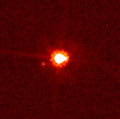
Eris is an outer Kuiper Belt object discovered in 2005.
It is shown here in an image from the Hubble Space Telescope along
with its moon, Dysnomia. Eris is approximately 27% more massive
than Pluto, although smaller in volume. Its discovery precipitated
a course of events that resulted in the IAU creating a new class
of planet in August 2006: the dwarf planet.
As of today, the IAU classifies Pluto, Eris, and asteroid belt object Ceres as dwarf planets. They also have proposed classifying Kuiper Belt objects Haumea and Makemake as dwarf planets, but as of 2019 many think more study of them is necessary before finalizing that determination.
Quaoar

In 2002, astronomers discovered Quaoar, a Kuiper Belt Object about half
the size of Pluto. Its orbit is about 4,000,000,000 miles away (about
one American billion miles beyond Pluto's orbit). The photograph at the left
is from the Hubble Space Telescope. It shows Quaoar in several positions in
its nearly circular orbit around the Sun. The two astronomers who discovered
this object, Michael Brown and Chadwick Trujillo, named it in honor of a
Native American god of creation.
Quaoar is a faint object, approximately magnitude 18.5 (too faint for the unaided eye to see). It is also small, about 800 miles (1300 kilometers) in diameter. At its distance, this is about 0.04 arcseconds. With the incredible resolving power of the Hubble Space Telescope, astronomers should be able to discover and measure many more Kuiper Belt Objects in the years to come. You can read more about Quaoar at the website of one of its discoverers, at Chad Trujillo's Quaoar Page.
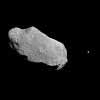 The Solar System has millions of asteroids. Most are in the Asteroid Belt,
which lies between Mars and Jupiter. Many more share the orbit of Jupiter;
they are known as the Trojan Asteroids. Some are closer to the Sun than
the Earth's orbit; these are known as the Aten Asteroids.
The Solar System has millions of asteroids. Most are in the Asteroid Belt,
which lies between Mars and Jupiter. Many more share the orbit of Jupiter;
they are known as the Trojan Asteroids. Some are closer to the Sun than
the Earth's orbit; these are known as the Aten Asteroids.
The asteroid at left is Ida. The small white dot on its right is its moon, Dactyl.
The largest asteroids are also known as the Minor Planets.
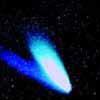 Thousands of comets exist past Pluto in the Kuiper Belt.
Thousands of comets exist past Pluto in the Kuiper Belt.
A sphere of comets surrounds our Solar System in what is called the Oört Cloud, named after astronomer Jan Oort, who proposed its existence. This spherical cloud contains about 10,000,000,000,000 (ten American trillion) comets. Sometimes a comet will leave the Oort Cloud and travel towards the Sun. When they are near the Sun, they develop tails and we can often see them from Earth.
Comets contain ice. When a comet approaches the Sun, some of its ice melts and forms a tail. This comet tail also contains a combination of water vapor and dust. The tail usually appears as two tails: a bluish tail of gas, and a whitish tail of dust particles. The tail only exists when a comet is close to the Sun.
When the Earth passes through the remains of a comet's tail, we have meteor showers.
The most famous comet is Halley's Comet, named after the astronomer who discovered its regular orbit. Halley's Comet orbits around the Sun in approximately 76 years. It is visible from the Earth when close to the Sun. Halley's Comet last came closest to the Sun in 1986, and will return in 2061.
The Hale-Bopp Comet was the last comet visible by the unaided eye, in 1997.
In December 2003, the Encke Comet was visible with binoculars in the Aquila constellation.
On 2 January 2004, the Stardust probe successfully traveled right through the head of the Wild 2 Comet and collected a sample of its dust. The probe will then return to Earth and send a capsule containing this sample back to Earth in January 2006. This is the first sample taken from a comet. Scientists believe that comets haven't changed much since the Solar System was first formed, so this is an exciting event in the world of astronomy. For a more complete story, which also contains a good description of comets, see JPL's Stardust Flyby Press Release, or visit JPL's Stardust Home Page.
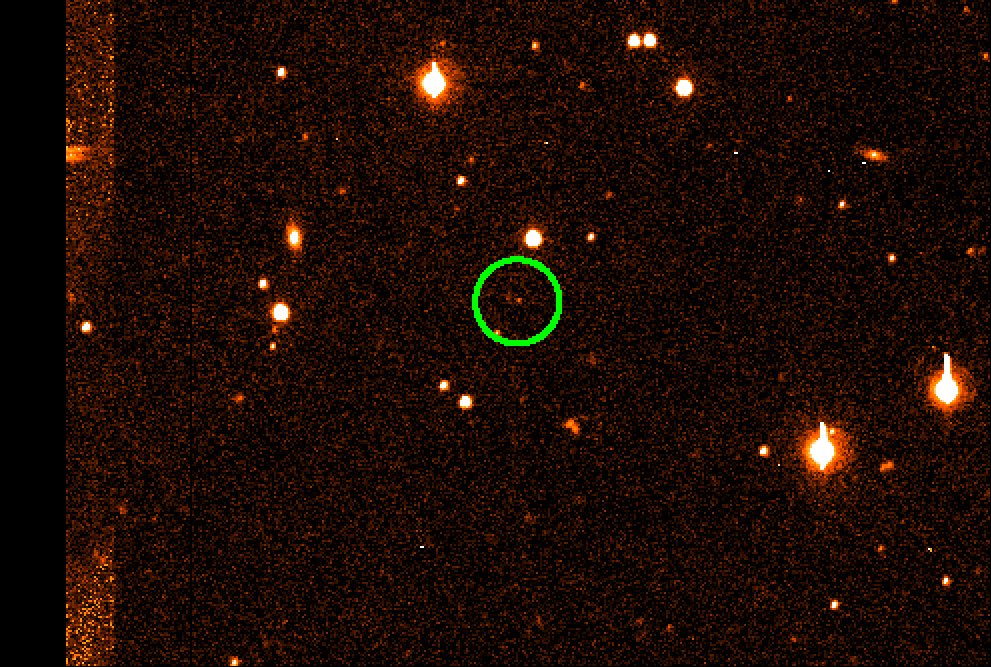 Sedna, first recognized as a minor planet on 14 November 2003 and reported
on 15 March 2004, is the first object of its kind to be discovered. Sedna
was named after an Inuit goddess of creation of the creatures of the Arctic
Sea. Sedna lies
past the Kuiper Belt, in what astronomers believe is the Inner Oört Cloud.
Comets, which are largely ice, orbit through this Oört Cloud. Sedna is very
large for an Oört Cloud object, about 1000 miles in diameter. It is believed
to be half rock, half ice.
It is also the second reddest object in the Solar System, next to Mars.
Sedna, first recognized as a minor planet on 14 November 2003 and reported
on 15 March 2004, is the first object of its kind to be discovered. Sedna
was named after an Inuit goddess of creation of the creatures of the Arctic
Sea. Sedna lies
past the Kuiper Belt, in what astronomers believe is the Inner Oört Cloud.
Comets, which are largely ice, orbit through this Oört Cloud. Sedna is very
large for an Oört Cloud object, about 1000 miles in diameter. It is believed
to be half rock, half ice.
It is also the second reddest object in the Solar System, next to Mars.
In addition to these unusual features, it has a highly elliptical orbit that extends out to approximately 84 American billion miles from the Sun. It journeys so far from the Sun that it takes about 10,500 years to complete its orbit. Compared to Quaoar's nearly circular orbit, Sedna points to an earlier time in our Solar System when another Sun close to our own probably exerted strong gravitational force on Sedna.
The animation to the right shows the three digital photographs taken on 14 November 2003. The green circle outlines Sedna. Click the animation for a larger view. You can read more about Sedna the minor planet, and find links to mythology about the Unuit goddess Sedna, at the web page of one of its discoverers, Mike Brown's Sedna Page.
| Home | Ephemeris | Solar System | History | Space & Time | Software | Books | Links | Feedback |
Copyright 2004–2019. All Rights Reserved. All images courtesy NASA/JPL unless otherwise noted.